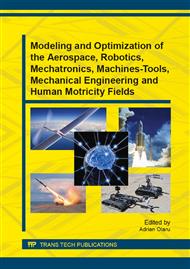[1]
Werner, Debra (2013).
Google Scholar
[2]
Dr Julian Simon (2006), The Aquarius, a proposal for a nano-satellites launcher vehicle, INTA, Torrej´on de Ardoz, Paper IAC-06-B5. 5. 05, Proceedings of the 57th IAC Congress, Valencia, Spain, Oct. 02-06.
DOI: 10.2514/6.iac-06-b5.5.07
Google Scholar
[3]
Koelle, Heinz Hermann (1961), Handbook of Astronautical Engineering, McGraw-Hill, N. Y.
Google Scholar
[4]
Lindberg, Robert E. (1989), Overview of the Pegasus Air-Launched Space Booster, SAE, Aerospace Technology Conference and Exposition, Anaheim, CA, Sept. 25-28.
DOI: 10.4271/892308
Google Scholar
[5]
Sarigul-Klijn, M., Sarigul-Klijn, N., Morgan, B., Tighe, J., Leon, A., Hudson, G. & McKinney, B., Gump, D. (2006), Flight Testing of a New Air Launch Method for Safely Launching Personnel and Cargo into LEO, AIAA-2006-1040.
DOI: 10.2514/6.2006-1040
Google Scholar
[6]
Norris, Guy (2012), Boeing Unveils Air-launched Space Access Concept, Aviation Week, 23 May (2012).
Google Scholar
[7]
** (2012), More on Boeing's small launcher concept, Aviation Week, 22 May (2012).
Google Scholar
[8]
Leone, D. (2013), Startup Generation Orbit Launch Service Bets Big on Small Space, SpaceNews, Nov. 26, http: /www. spacenews. com/article/launch-report/38365startup-generation-orbit-launch-service-bets-big-on-%E2%80%98small-space%E2%80%99.
Google Scholar
[9]
Rugescu, R. D., Cr. E. Constantinescu, M. Al. Barbelian, Alina Bogoi, and C. Dumitrache (2011).
Google Scholar
[10]
Rugescu, R. D. (2000), Theory of aerospace flight – optimization of atmospheric ascent, Ed. ManDely, Bucharest, 218 pages.
Google Scholar
[11]
Rugescu, R. D., D. Mortari, I. Farcasanu, V. Martin, S. Matei, V. Silivestru, and D. Dragomir (2008).
Google Scholar
[12]
Steven J. Zaloga (1989), Soviet Air Defense Missiles: Design, Development and Tactics, ISBN 0710605897, Jane's Information Group (November 1989).
Google Scholar
[13]
Rugescu, R. D., Ciprian Dumitrache, and Florentina Ionescu (2010), Gasdynamic ailerons, Depot invention patent U.P.B. no. A-2010-01210, Bucharest 26. 11. 2010 published in RO-BOPI no. 5, page 24, 30 May (2012).
Google Scholar
[14]
Rugescu, R. D. (2010), Compound rocket motor, process and method for increased propulsive eficiency, Depot for invention patent U.P.B. no. A-2010-01213, Bucharest 26. 11. 2010, published in RO-BOPI no. 5, page 40, 30 May (2012).
Google Scholar
[15]
Rugescu, R. D., C. E. Constantinescu, D. R. Rugescu, B. Marcu, F. Ionescu, C. Dumitrache, M. O. Stanciu, E. Micu, S. P. Vataman, A. Ciocanea, S. Budea, I. Farcasan (2010).
Google Scholar
[16]
Rugescu, R. D., (2010), Method and onboard device for controlling large flow rates of liquid, Depot invention patent U.P.B. no. A-2010-01209, Bucharest 26. 11. 2010, published RO-BOPI no. 5/2012, page 24, 30 May (2012).
Google Scholar
[17]
Rugescu, R. D. (2000), Burning Laws of Solid Propellants by Multiple Splines, Scientific Bulletin of U.P.B., series B, Chemistry and Materials Science, 62, 1(2000), pp.41-50.
Google Scholar
[18]
Rugescu, R. D. (2001), A Multiple-Deviator Method for Extremal Flight, Proceedings of the 26th Annual A.R.A. Congress, Montreal, Canada, 25-29 July, (2001).
Google Scholar
[19]
Rugescu, R. D. (2001).
Google Scholar
[20]
Rugescu, R. D. (2001), On Second Order Variational Extrema, Sci. Bull. U.P.B. ISSN 1223-7027, series A Applied Mathematics and Physics, 63, 2(2001), pp.29-34.
Google Scholar


